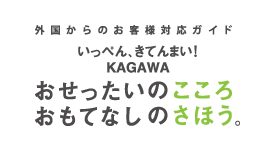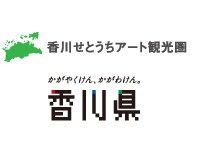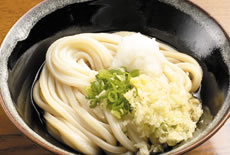
Everyone who comes to Kagawa Prefecture heaps the highest praises on the flavor of Sanuki udon. This dish was developed using the area’s abundant resources of wheat, soy sauce, dried sardines, and other ingredients to make noodles. The techniques for making Sanuki udon have been refined and passed down through the years to create the current form of the dish, which is a staple of culinary culture in the region.
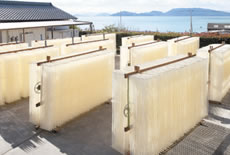
Shodoshima is considered one of Japan’s Three Great Somen Production Areas. These noodles are hand-made, with no reliance on machinery, as they are stretched with a unique method from their thick initial shape into their extremely thin final form and then dried in the sun to bring out their full flavor, which reflects the loving attention that goes into every noodle.
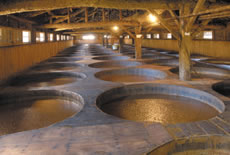
The most versatile ingredient in Japanese cuisine, soy sauce is also a flavoring well loved throughout the world. Kagawa Prefecture has long been known to produce fine soybeans, wheat, and salt, and its climate and terrain are perfect for the making of soy sauce. It is considered to be the prime area for production of soy sauce in the country. The soy sauce makers on Shodoshima Island allow visitors to take tours of their storehouses.
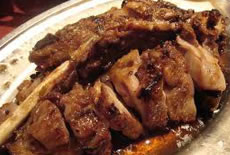
Chicken on the bone is simple chicken, thickly coated with flavorings before cooking. The skin is crisp and savory, and flavorful juices squirt out of the meat when you bite into it. You can choose between the soft and juicy flesh of young chickens or the firm flesh of older birds, which releases a surge of flavor each time you bite into it. There have been restaurants specializing in chicken on the bone for over 50 years here in Kagawa. This dish has become a popular standard menu item, a favorite of residents of the prefecture.
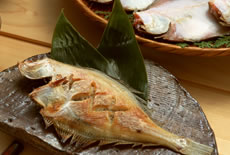
The Inland Sea is a treasury of foodstuffs. Seasonal fish caught in the region are flavorful, with a delicate, satisfying taste. The prefecture offers many restaurants where you can enjoy fresh Inland Sea seafood in all its forms: raw, grilled, boiled, or coated with batter and fried as tempura.
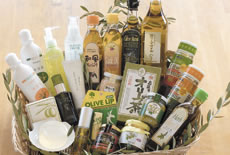
The calm, Mediterranean climate of Shodoshima Island in Kagawa Prefecture makes for the perfect place for producing olives. The olive was designated as Kagawa’s official prefectural flower in 1954 and as its official prefectural tree in 1967. From mid-October to mid-November, the green olives picked from Shdoshima’s trees are salted and cured. Then from December through January, the olives, which have become dark purple in color, are pressed to extract their fine oils. This oil makes for exemplary non-drying olive oil and is used widely in food products, medicines, cosmetics, etc. It is a favorite souvenir of people who visit Kagawa Prefecture.
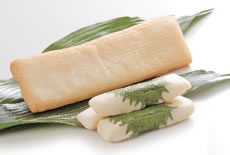
Kamaboko fish paste has been manufactured in Kagawa Prefecture, from the small fish of the Seto Inland Sea, since the middle of the Meiji Period. In addition to steamed and grilled kamaboko, there are many other means of preparation, such as tempura or chikuwa (bamboo-shaped fish paste cylinders) for this delicacy. Containing fresh ingredients of the Seto Inland Sea, kamaboko is made from ground fish meat and has a flavorful taste and delightful texture. In Kagawa, kamaboko often is eaten along with udon noodles, giving this Kagawa dish even more local flavor, and it is even enjoyed in the other prefectures of Shikoku, as well as in Kyoto, Osaka, and Kobe.
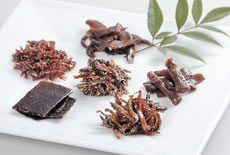
Immediately after the end of World War II, the production of tsukudani (seafood such as shellfish boiled in sweetened soy sauce) began on Shodoshima in an attempt to take advantage of the resources of the island’s soy sauce industry. It became the fresh new face of local production on the island. Today, in addition to the fine ingredients, meticulously perfected flavor, and savory taste, Shodoshima offers a variety of tsukudani products that have reduced sodium, no preservatives, and other high-quality characteristics.
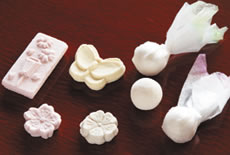
Sanbonto sugar is made from the sugar cane that is harvested every year in December. The juices from the pressed sugar cane are poured into a cauldron and the moisture is boiled away. The intermediate product is called shiroshitato, and it is poured into a cotton sack and then processed in a wooden compressor called an oshifune. From there it is kneaded 5 times to to make the final product. This sugar derives its name from the process used to make it in the past, in which it was kneaded 3 times.
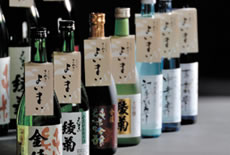
Through the skilled expertise of its finest brewers, Kagawa produces smooth, full-bodied, mellow Japanese sake, made from fine rice grown under the prefecture’s sunny skies and high-quality water flowing underground from the Asan Mountain Range.
